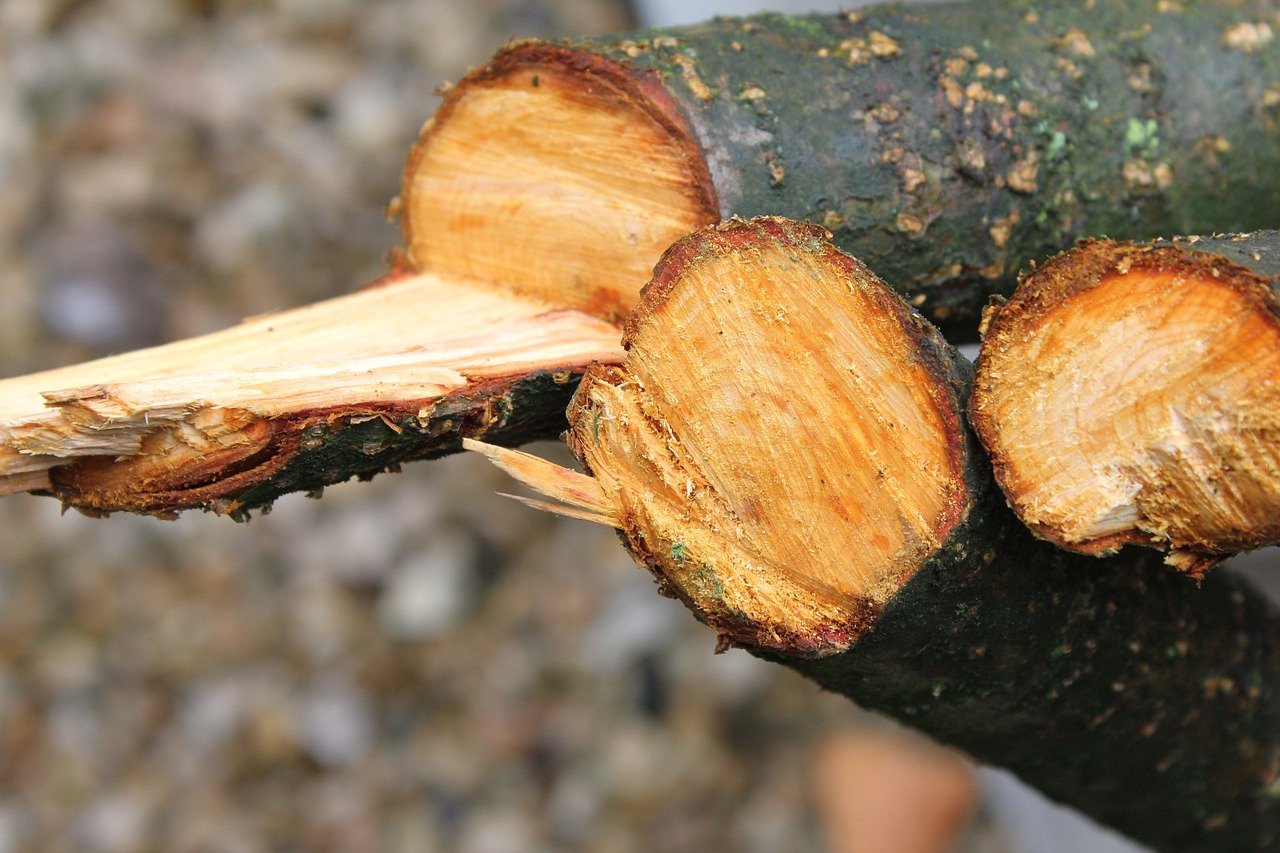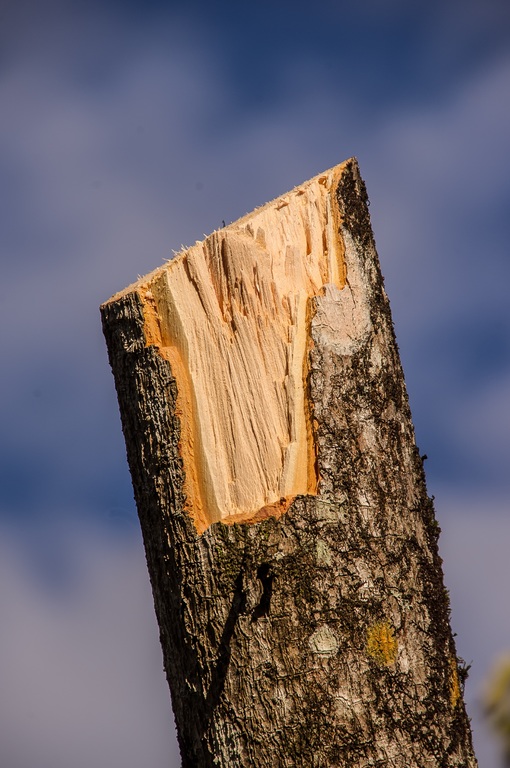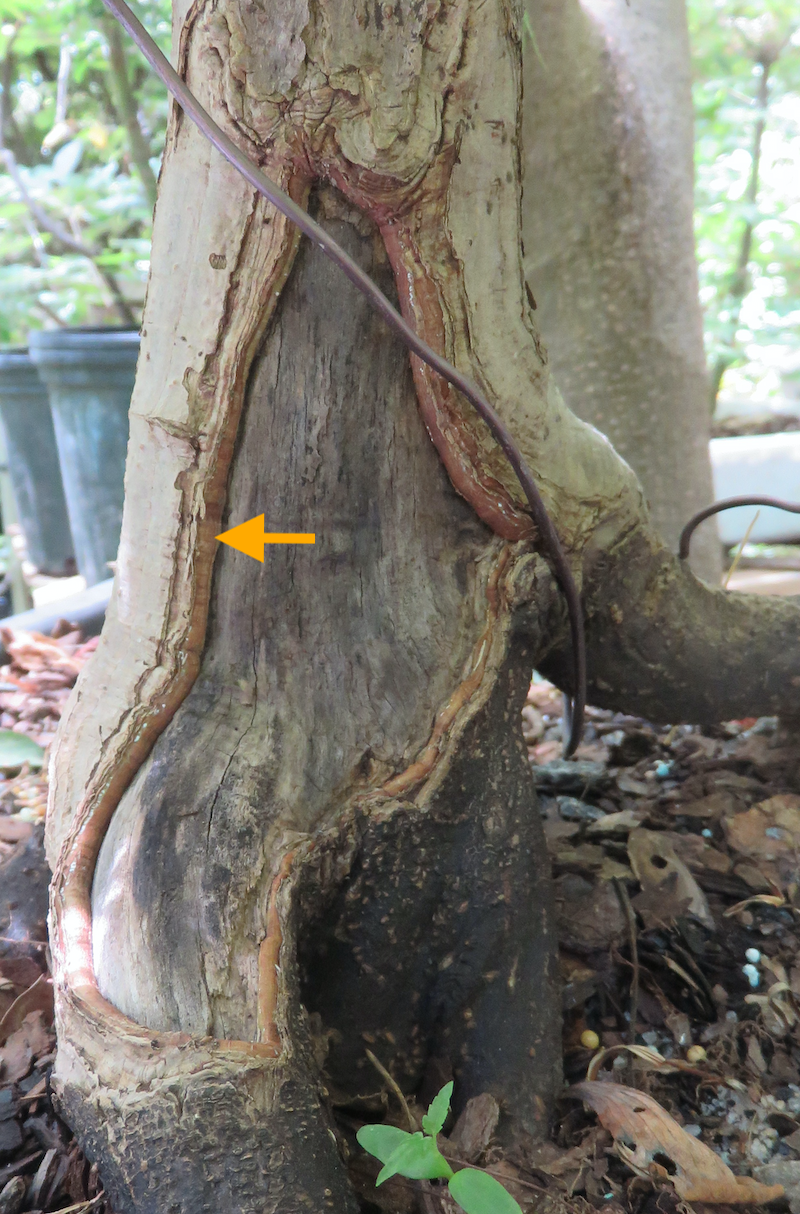Chapter 35 Developing Woody Structures: Trunk and Main Branches
The visible above-ground elements of a bonsai include both woody parts and foliage. How to develop the nebari (basal root flare) is described on the page on root development.. This page focuses specifically on how to develop the visual triangle, trunk taper, major branches, and general movement. Techniques for developing the fine terminal branches and foliage pads are described in Sections 35 and 39.
This page incorporates information from these previously published resources:
- Bonsai Basic Teaching Program, by Dennis Makishima, Golden State Bonsai Federation, 12/05/2008
- Fundamental Bonsai Design - Applying Rules Where None Exist, by Randy Clark, Bonsai Learning Center, Charlotte, NC
- Bonsai Teachers’ Guide, by Bonsai Clubs International, http://bonsai-bci.com

Pruning and wiring a seedling of pine tree to obtain an informal upright style bonsai. 1, 2. Cut and remove the central bud. 3. Transplant the seedling at an angle. 4-6. After 3-4 years, cut extra branches, leaving only alternating branches. Remaining branches and trunk are wired to create more movement. 7. After 2 years of fine shaping, the needles of the pine now are smaller and growing upright because they have more light. Link to original image
35.1 Developing the Triangular Silhouette
Most bonsai have an approximately triangular shape, both when viewed from above, and from the front. Looking down from the apex, the front of the tree forms the longest side of an asymmetric triangle, with the tips of the three lowest branches forming the corners. Looking at the tree from the front, the two lowest branches form the base of another asymmetric triangle, with the apex at the peak of the triangle. The branches and foliage pads on all of the other branches should fit within these two triangles.
The asymmetric triangle is a theme that runs through all bonsai designs. A single tree presents a single triangle. A twin trunk tree presents two triangles which are arranged to create one overall triangle. Cascade bonsai present triangles which are turned upside down. Forest and group plantings are composed of a series of triangular groupings which are then arranged to complete an overall larger triangle for the entire composition.

Examples of the asymmetric triangular silhouette that underpins all bonsai designs. Link to original Image 1; Image 2; Image 3; Image 4.
35.2 Planning Pruning Cuts of Woody Trunks and Branches
Woody trunks and branches that are pruned correctly can heal over the cut, or wall off the site internally to prevent the spread of disease. Conversely, incorrect pruning cuts make the tree more susceptible to disease and die-back.

Planning pruning cuts. When pruning full size yard trees, the recommendation is to make cuts 1 then 2 to remove most of the weight from the branch, before making a final cut at 45o that does not break the branch collar. For bonsai, branches are cut closer to the trunk. The ideal cut follows the green line from just outside the branch collar to a point below the branch. The cut should be angled away from the body of the trunk into the area marked B, and avoid cutting into the area marked A. Link to original image.

A recently pruned branch. This branch was cut at an angle away from the main trunk, leaving a small stub. This is standard for landscape trees, but not recommended for bonsai. Assuming this was a healthy branch, the thin layer of cambium that separates the bark and deeper wood will begin to expand and migrate out, covering the bare wood. The outermost layer of cambium will form bark to seal the wound. Link to original image.
These are examples of poorly executed pruning cuts, and how they resulted in die-back.

Poorly made pruning cuts. The main cuts are ragged, and one has a tongue of bare wood that can catch water and foster decay. Also, the three branches are close enough to rub together; the middle branch should be cut back several more inches or removed entirely. Link to original image.

Another poorly made pruning cut. Part of the bark and cambium has been broken off from the remaining stub, exposing the wood underneath to decay. Link to original image.
Dieback due to a poorly made pruning cut. The main cut was made in the space between active buds (the bud scar is about half-way down the dying stub). A bud further back on the branch has developed into the new branch leader. The best way to prevent decay is to prune the stub back to the collar of the live section, and encourage the cambium to roll in and close the site. Link to original image.
The main stub of this branch was pruned too far forward from active buds. As a result, the wood of the main branch has died back to the point where several active buds have emerged and formed a spoke-like set of new extension branches. While not an immediate threat to the tree overall, this dead stub could provide a path for disease pathogens to enter the cambium. it would be better to prune this stump back to sound wood and cambium, then either try to close the cut end by letting the cambium roll in, or treating it with a deadwood preservative. Only 1-2 of the emerging branches are needed to continue developing the branch. Link to original image.
35.3 Developing Trunk Taper
The nebari should transition smoothly into the trunk. The trunk in turn should taper from the base to the apex of the tree. There are several ways to improve trunk taper.
35.3.1 Sacrificial Branches and Stems
As a tree grows, each branch sends nutrients back and stimulates the trunk below it to expand in diameter. The more branches there are and the more foliage they have, the more quickly the trunk diameter expands. We can direct this process to thicken the trunk systematically.
If a tree has multiple branches on all sides of the trunk, selectively removing more branches near the top and leaving more near the bottom will create a nutrient gradient that will lead to a naturally tapered trunk. Once the trunk has developed strong taper, any branches that will not be developed further are removed.
alt text
Most trees will not have enough branches to build taper this way, but many will have one or more branches or stems that can be used as sacrificial branches and stems. Sacrificial branches are allowed to get as long and as thick as possible, but eventually are removed when the trunk reaches the desired thickness. Their sole purpose is to cause the trunk to thicken, not to be part of the final branch set. Sacrificial stems help ensure a lower branch has enough nutrients to grow and develop to the point that it can survive on its own.

A crabapple with a sacrificial stem. The side branch (orange arrow) was a small bud last year. I left the trunk above it, but kept the foliage cut back, to encourage the sided shoot to grow. Next year I will remove the entire stem above the blue arrow. Original image by Dan Johnson.
Sacrificial branches can be grown out of the top of the tree to thicken the entire trunk, or near the base to thicken just the base. Ideally the sacrifice branches will be located on what will be the back of the tree, so that the pruning scars will not show. There are two options if the pruning scars are located near the front of the tree. If cavities look natural on the tree species, the pruning scar can be carved out to create a uro feature. Alternatively the pruning scars can be closed over by encouraging the cambium to roll in (see Covering Pruning Scars below).
35.3.2 Clip and Grow Technique
If a tree does not have enough branches to use the sacrificial branch method, trunk taper also can be developed by repeatedly cutting the trunk back, then training either an existing branch or a newly emerging apical shoot to become a new leader. The new leader is allowed to grow without restriction until it is 2/3 to 3/4 the diameter as the trunk below the cut. Then the leader is cut back again and the process repeated.
Proper pruning technique is very important for this technique to work well.
alt text
alt text



35.4 Developing Branch Taper and Ramification
A modified version of the clip and grow technique also is used to build branches. The main difference is that several branches will be developed at the same time rather than just one leader.
For many species, shading by the larger branches higher on the trunk will prevent smaller branches below them from growing out. So whenever possible, the branches located further down on the trunk should be developed before allowing branches further up on the trunk to grow out.
Start with the lowest tier of branches on the trunk. Let them grow freely without pruning for a full season. Keep all higher branches pruned back so they are not shading the lowest tier. Alternatively, higher branches can be partially defoliated so they let more light penetrate to the lower branches.
At the start of the next growing season, check the diameter of each branch. If the branch is not large enough yet, let it continue growing for another season.
When branches in the lowest tier have reached the desired size, cut them back and begin building branch tip ramification and foliage pads. The page on pinching and pruning outlines these processes generally; look at each species guides for additional details.
alt text
Fig. #: Text. Link to original image
alt text
Fig. #: Text. Link to original image
35.5 Covering Pruning Scars
Trunk and branch pruning can create large scars. Some scars can be situated at the back of the tree, or turned into jin, shari, and uro. Here are two ways to hide scars that affect the visible parts of the tree.
35.5.1 Stimulating Cambium Growth
Branch and trunk pruning scars can be reduced or even closed by encouraging the cambium around the wound to migrate in and re-cover the bare wood. Under ideal conditions this technique can close very large areas of bare wood. I’ve successfully closed a gap approximately 4 x 8 inches in the bark of a maple growing in open ground, and a gap 1.5 x 5 inches just above the nebari on a potted maple.
When the cambium is first broken by a pruning cut, cells start to proliferate and seal the edge of the wound. Over several weeks cambium cells migrate out from the original cut line and form a corky or woody ridge on the recently cut surface. This process slows after a few months, then eventually stops. If the leading edge is gently wounded again before migration shuts down, it will continue growing inward until the migrating edges meet and fuse.
Cambium does not migrate easily over raised wood or deep depressions, which is why bonsai pruners are designed to make a slightly concave cut. It also does not migrate well over old, dry wood. Ideally, this should be done while the newly pruned site is still green and holds moisture in the wood.
- Make the branch pruning cut using concave cutters or a pruning saw.
- If needed, use a chisel to create a SMALL concave area. Keep the area as smooth as possible.
- Look closely at the edges of the newly cut bark. The cut edge should be clean with little or no torn fibers.
- Smooth any ragged edges on the bark by cutting them off with a sharp knife or single-edge razor. Try not to cut down into the wood under the cambium layer.
- When finished trimming the edges, use a misting bottle filled with spring water (or tap water if allowed to sit several days to de-chlorinate) to rinse away any debris and hydrate the exposed edges of the cambium.
- Let the wound air dry. DO NOT seal the wound with Kiyonal or other hard sealant. Glue-based sealants like Kiyonal prevent the cambium from rolling in and adhering to the wood.
- After a week or two, look for a small layer of green or pale brown material starting to move out from the cut edge. This is the migrating cambium. Once it begins to migrate, check it every week or two to monitor its progress.
- When the migrating layer starts to slow down, GENTLY scrape the leading edge away with a dull knife blade. The goal is not to cut any of the new material away, just scratch off the surface and re-expose the gren cambium beneath it.
- Rinse off the debris with clean water, and leave the wound to continue rolling in.
- Repeat the process of scraping the moving edge every time it starts to slow down. After one or more cycles, the migrating edges will meet and fuse. Once the edges fuse, leave the site alone. The bark with thicken up on its own, completely hiding the scar.
1. 
2. 
3. 
4. 
5. 
This is a large Osakazuki Japanese maple that was damaged when a red oak fell in our yard. It has exceptional character, but the accident stripped the bark from several areas of the trunk. Rather than lose the tree I have spent several years rolling in the cambium to close the wounds. Image 1. The main un-covered area still remaining on the trunk of this tree. The bare area is about 3 inches long, and 1 inch at its widest point. The orange arrow indicates the line of rolling cambium, which is covered by a thin corky layer. Image 2. The area on one side of the original wound that has been successfully re-covered with bark. An equivalent area on the other side has been re-covered as well. Image 3. Additional areas where the wound has been re-covered. I expect to be able to seal the final gap on this part of the tree in one more growing season. Image 4. Close-up of the newly wounded cambium. Orange arrows point to the protruding cambium that I just scraped with the blade of a pocket knife to stimulate it. Over the next few weeks this region will bulge and grow towards the green wound edge. Note that some of the wood has been bare long enough to dry out and start to mold (blue arrows). Once the cambium gets closer I will sand the area and apply oil preservative to avoid trapping the mold under the new bark. Image 5. As cambium rolls, the older bark near the edge can be pushed up and away (orange arrows). This is normal. Once the new underlayer of bark has hardened, simply chip the old edges off with a finger nail. Original images by Dan Johnson.
Not all trees will close up scars equally well. Pruning wounds close quickly on trident, Japanese, and red maples, and Chinese elms. Pruning wounds are slower to close on azaleas, pines, and confers in general. Wounds close poorly or not at all on American hornbeams, bamboos, bougainvillea, gingkos, and Shimpaku junipers. The individual species guides include any information I could find about how readily wounds close on that species.
35.5.2 Bridge Grafting
If one or more new buds break and emerge from the branch collar immediately below a pruning scar, the green woody branches can be folded up and stapled to the bare wood, bridging the scar. The graft is sealed using either grafting tape, parafilm, or modeling clay to maintain moisture. Over 1-2 years the green wood will fuse and start to spread over the old scar. Once the wound is hidden, the covering and foliage can be removed, leaving just the woody bark.
Like the previous technique, this does not work for all species. It tends to work better on species that are easily grafted like crabapples, cherries, apricots, and maples. It also is a good way to hide scars on ficus, which is the only species I have personal experience using it on. I’ve heard of it being used on other species, but not as often.
alt text
Fig. #: Bridge grafting to close a scar. Link to original image

